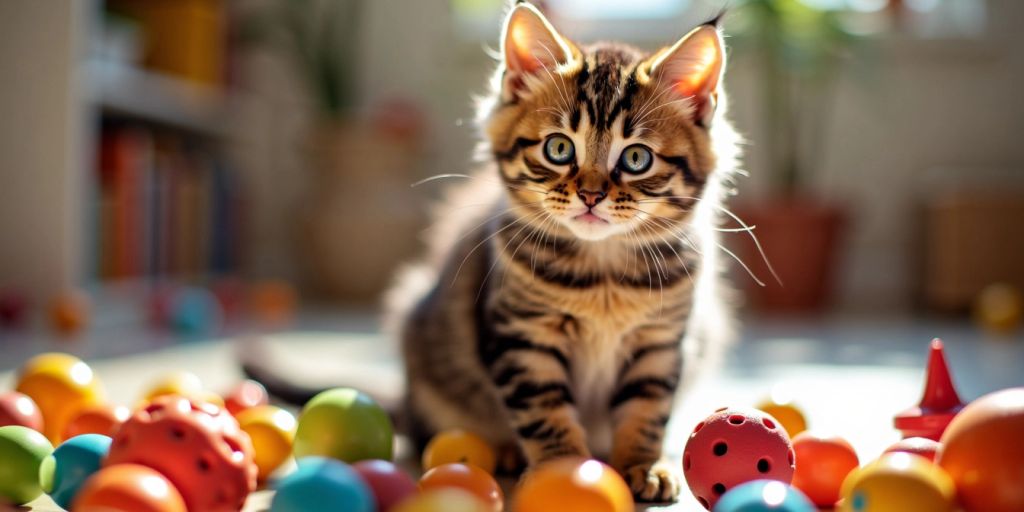Teaching your cat commands can be a fun and fulfilling experience. Not only does it help improve communication between you and your feline friend, but it also strengthens your bond and keeps your cat mentally engaged. In this guide, we will explore easy methods for training your cat and the benefits of teaching them commands and tricks.
Key Takeaways
- Training your cat enhances communication and builds trust.
- Understanding how cats learn is key to successful training.
- Using positive reinforcement makes training more effective.
- Creating a calm training environment helps your cat focus better.
- Teaching basic commands can solve common behavior issues.
The Importance Of Teaching Cat Commands
Teaching your cat commands is more than just a fun activity; it plays a crucial role in enhancing your relationship with your feline friend. Training helps improve communication between you and your cat, making it easier to understand each other’s needs and behaviors. Here are some key reasons why teaching commands is important:
Enhancing Communication
- Clear Signals: Commands provide clear signals for your cat, helping them understand what you want.
- Reduced Frustration: When your cat knows commands, it reduces frustration for both of you, leading to a more harmonious home.
Building Trust
- Bonding Experience: Training sessions can strengthen the bond between you and your cat, fostering trust.
- Positive Interactions: Using treats and praise during training creates positive experiences, making your cat more comfortable around you.
Promoting Mental Stimulation
- Engaging Activities: Teaching commands keeps your cat mentally stimulated, which is essential for their well-being.
- Preventing Boredom: A bored cat may develop unwanted behaviors, so training can help keep them engaged and happy.
Remember, the benefits of cat training are vast. Training provides mental and physical stimulation as well as positive social contact.
In summary, teaching your cat commands is a rewarding experience that enhances communication, builds trust, and promotes mental stimulation. It’s a win-win for both you and your furry companion!
Understanding Feline Learning Styles
Cats are unique learners, and understanding their learning styles can make training more effective. Here are some key methods:
Observational Learning
Cats often learn by watching others. If they see another cat or even a human performing a task, they may try to imitate that behavior. This is why having a well-trained cat can help teach others in the household.
Positive Reinforcement
Using positive reinforcement is crucial in cat training. This means rewarding your cat with treats, praise, or playtime when they perform the desired behavior. This encourages them to repeat the action. Here’s a simple breakdown of how to use positive reinforcement:
- Step 1: Identify the behavior you want to encourage.
- Step 2: Use a clicker or a verbal cue when they perform the action.
- Step 3: Immediately reward them with a treat or praise.
Motivation Factors
Understanding what motivates your cat is essential. Different cats respond to different rewards. Some may prefer treats, while others might enjoy playtime or affection. Here’s a quick list of common motivators:
- Food treats
- Toys
- Affection
- Playtime
Knowing your cat’s learning style and motivation can greatly enhance your training success. Tailoring your approach to their unique needs fosters a stronger bond and makes training enjoyable for both of you.
By recognizing these learning styles, you can create a more effective training plan that suits your cat's personality and preferences. This understanding is key to building a positive training experience.
Essential Tools For Training Cats
Training your cat can be a fun and rewarding experience, but having the right tools is essential. Here are the key items you’ll need to get started:
Clickers And Target Sticks
- Clickers are small devices that make a sound when pressed. They help mark the exact moment your cat does something right.
- A target stick is a stick with a ball at the end that your cat can touch with their nose or paw. This helps guide them during training.
- You can find a great option in the Cat School Clicker Training Kit, which includes both a target stick and a quiet clicker.
Treat Selection
Choosing the right treats is crucial for motivating your cat. Here are some tips:
- Use treats that your cat loves. This could be dry kibble, freeze-dried treats, or even small pieces of wet food.
- Experiment with different types to see what excites your cat the most.
Training Environment
Creating a good training space can make a big difference:
- Minimize distractions by choosing a quiet area in your home.
- Set up a routine for training sessions, so your cat knows when to expect them.
- Involve family members to make it a fun group activity.
Training your cat not only teaches them commands but also strengthens your bond. It’s a great way to spend quality time together!
Basic Commands Every Cat Should Know
Teaching your cat basic commands is essential for effective communication and a happy relationship. Here are some key commands every cat should learn:
Teaching Sit And Stay
To teach your cat to sit and stay, follow these steps:
- Find a quiet space free from distractions.
- Use a treat to get your cat's attention.
- Gently push down on their hindquarters while saying "sit."
- Once they sit, reward them immediately with a treat and praise.
- Gradually increase the duration of the "stay" command.
Coming When Called
Getting your cat to come when called can be a game-changer. Here’s how:
- Use a specific sound or word consistently.
- Reward them with a treat when they respond.
- Practice this regularly to reinforce the behavior.
Using The Litter Box
Teaching your cat to use the litter box is crucial for a clean home. Here’s a simple approach:
- Place the litter box in a quiet, accessible area.
- Show your cat where it is and encourage them to explore.
- Reward them when they use it correctly.
Remember, patience and consistency are key to successful training. Keep sessions short and fun to maintain your cat's interest and motivation!
By mastering these basic commands, you can unlock endless purr-fect moments! Ensure your feline's peak health and happiness today!
Fun Tricks To Teach Your Cat
Teaching your cat fun tricks can be a delightful way to bond and keep them mentally active. Cats can learn a variety of tricks that not only entertain but also strengthen your relationship. Here are some enjoyable tricks to consider:
High-Five And Paw Shake
- Start with a treat: Get your cat's attention with a tasty treat.
- Encourage the action: Hold your hand out flat, palm facing your cat. When they touch your hand with their paw, click and reward them.
- Repeat: Keep practicing until your cat understands the game.
Jumping Through Hoops
- Use a target stick: Lead your cat through a hoop using a target stick or a treat.
- Reward: Click and treat when they successfully jump through.
- Practice: Gradually increase the height of the hoop as your cat gets better.
Rolling Over
- Get your cat to lie down: Start with the ‘lie down’ command.
- Use a treat: Move the treat from their nose to their side, encouraging them to roll.
- Click and reward: When they roll over, click and give them a treat.
Remember, patience and positive reinforcement are key to teaching your cat these tricks. Keep sessions short and fun to maintain their interest!
Addressing Behavioral Issues Through Training
Training your cat can help solve many behavior challenges. By using the right techniques, you can manage issues like scratching, excessive meowing, and aggression. Here are some effective strategies:
Managing Scratching
- Provide Alternatives: Offer scratching posts or pads to redirect their behavior.
- Use Deterrents: Apply double-sided tape or citrus scents on furniture to discourage scratching.
- Reward Good Behavior: When your cat uses the scratching post, give them a treat or praise.
Reducing Excessive Meowing
- Identify Triggers: Pay attention to when your cat meows the most. Is it during playtime, mealtime, or when they want attention?
- Set a Routine: If you notice patterns, you can predict when your cat will want playtime, mealtime, and quiet time, and plan your routine around this cycle.
- Ignore Unwanted Meowing: If your cat meows for attention, try not to respond immediately. This teaches them that meowing won’t get them what they want.
Dealing With Aggression
- Stay Calm: If your cat shows aggression, avoid yelling or punishing them. This can increase their stress.
- Redirect Their Energy: Use toys to distract them and channel their energy into play.
- Consult a Vet: If aggression persists, it might be a sign of health issues, so a vet visit is essential.
Training is not just about correcting bad behavior; it’s about understanding your cat’s needs and building a stronger bond with them.
By addressing these behavioral issues through training, you can create a more peaceful environment for both you and your feline friend.
Creating A Positive Training Environment
Creating a positive training environment is essential for effective cat training. A calm and stimulating space can significantly enhance your cat's learning experience. Here are some key aspects to consider:
Minimizing Distractions
- Choose a quiet area for training sessions.
- Turn off loud noises like TVs or radios.
- Limit the presence of other pets during training.
Setting Up A Routine
- Schedule training sessions at the same time each day.
- Keep sessions short, around 5-10 minutes, to maintain your cat's focus.
- Use a consistent cue for starting and ending training.
Involving Family Members
- Encourage family members to participate in training.
- Ensure everyone uses the same commands and rewards.
- This helps your cat understand that training is a fun, shared activity.
Remember, understanding your cat's behavior is crucial. A positive environment not only aids in training but also strengthens the bond between you and your feline friend. By creating a space that is both calm and engaging, you can help your cat thrive and learn effectively.
Final Thoughts on Cat Training
In conclusion, teaching your cat commands is more than just making them obey; it’s about creating a loving bond based on trust and understanding. By using positive methods and being patient, you can enjoy a fun and rewarding training experience. Remember to keep your sessions short and full of praise, and always reward your cat for their efforts. Start your training journey today, and watch your feline friend thrive as they learn new skills!
Frequently Asked Questions
Why should I teach my cat commands?
Teaching your cat commands helps you communicate better with them, builds trust, and keeps their mind active.
Can all cats learn commands?
Yes, all cats can learn commands, but some may take longer than others depending on their personality.
What is the best way to train a cat?
The best way to train a cat is through positive reinforcement, like treats and praise.
How long should training sessions be?
Keep training sessions short, around 5 to 10 minutes, to hold your cat's attention.
What if my cat doesn’t respond to treats?
If your cat isn't motivated by treats, try different kinds of rewards, like toys or playtime.
Is it too late to train my older cat?
It's never too late! Older cats can learn new tricks and commands just like younger ones.



